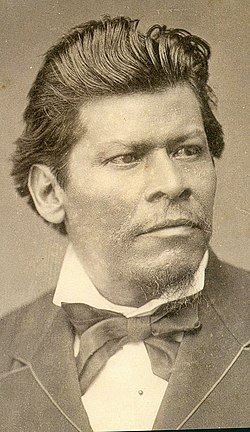Coalition of Coconeh Calpotlin
Coalition of the Coconeh Calpotlin | |
|---|---|
Motto:
| |
Anthem:
| |
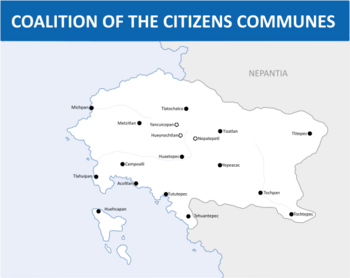 | |
| Capital and largest city | Yancuicopan |
| Official languages | Nahuatl |
| Recognised national languages | Otomí, Matlatzinca, Mazahua, Mazatec, Huaxtec, Tepehua, Popoloca, Popoluca, Tlapanec, Mixtec, Cuicatec, Trique, Zapotec, Zoque, Chochotec, Chinantec, Totonac, Cuitlatec, Pame, Mam, Tapachultec, among others |
| Demonym(s) | Coconeh |
| Government | Federal socialist republic |
• Calpuleque | Oaxhicatl |
• Tlacaquini | Huanitzin |
• Tetlamachiliani | TBD |
| Legislature | Mochicalpulleh Tlahtoloyan |
| Area | |
• Total | 634,192 km2 (244,863 sq mi) |
| Population | |
• 2018 estimate | |
• 2012 census | 44,783,889 |
• Density | 86.38/km2 (223.7/sq mi) |
| Currency | Mutual Credit |
| Date format | dd.mm.yyyy |
| Driving side | right |
| Internet TLD | .tl |
The Coalition of Coconeh Calpotlin, also known as the Coalition of the Free Calpotlin, Calpullali, or by the acronym of CCC, officially known as the Chimalli-Amoxtli Coconeh Calpotlin is a Calpulist federal state in the Eastern Continents. It has a population of roughly 55 millions inhabitants. It’s capital is Yancuicopan. Before the Cloud and Flower Revolution, the country was known as the Azcapotzalco Tlahtoloyan or “Empire of Azcapotzalco”.
After the fall of the Nazahualkanids Dynasty, the Tlahtoloyan was replaced by the Altepetl Federation. This regime was, however, itself very weak and unstable, finally dissolving during the War of Thousand Colors that ended with the victory of the Calpulist faction and the creation of the current Coalition.
Etymology
A Calpulli, translated as “Great House”, “Communal House”, or “District”, is a traditional administrative and social division inside the Coalition. One of the great objective of the CCC was to create a socialist society capable of being understood and accepted by the general population. To this day, the nation is officially only a “Coalition” of autonomous Districts, with barely any administrative division recognized beyond it.
“Coconeh”, meaning “Children", is the accepted political term to design every citizen of the CCC without distinction of ethnicity or regional origin.
History
First Tulla
Around 300 BC, the city of Tulla began expanding in the Xaltocan Valley, similarly to other great cities like its rival Cuilca, destroyed during a volcanic eruption in 55 BC. After this event, Tulla was left free to expand without any rival to balance its rise.
During the following centuries, the city became the heart of a vast network of tributaries and of economical and cultural dependencies. It’s wealth was unequaled and by 450 AD, it had reached it height. It’s only during the 7th century that Tulla started to decay due to unfavorable climatic changes and waves of migrating Chichimecas. The temples and palaces of the cities were burned during what is supposed to have been massive popular unrest and riots, and then Tulla was abandoned by its inhabitants.
Intermediate Period
The First Chichimeca Migration brought in the once Tullan-held territories new populations and new languages that added themselves on top of the Oto-mangues speakers of the preceding era. It was during that time that the Toltec, Chichimecas who adopted Tullan culture, emerged, and developed their own city-states alongside those of the natives, distancing themselves from their nomadic past.
To the south, the Totonacs whom had come to dominate the second half of the Tullan era re-centered their civilization around another major trade hub: the city of Tajin which had been spared from the Chichimecas invasions. Chroniclers from later periods would refer to the Intermediate Period by the poetic phrase of “Dogs packs, Builders’ cities, and a Thunderous Voice”.
Second Tulla
“Second Tulla” is the name commonly given to the Toltec city of Zuluya which managed to become the sole hegemon of most of what had been the First Tulla’s core territories and of almost all Toltecs cities. Even at its height, however, it was permanently in conflict with Tajin, which had become an important hegemon in its own right, taking over vast swaths of what is today the south of “Calpullali”. Lasting from the 10th to the 13th century AD, this period received the poetic name of “North and South” ("Tlatziuhqui iuan Ytzicotla”) by later chroniclers, referring to a famed poetry compendium of the same name.
Like the previous Tulla, this era ended with a second migration wave of Chichimeca, when the NahuatlNahuatl-speaking people destroyed both Zuluya and Tajin. The Nahuas settled down in the lands they had conquered and started to adopted the Toltec culture themselves. This led to the period historians know as the “Second Intermediate Period” which is traditionally considered to end with the reign of the Tepanec Tlatoani Tezozomoc (1349 - 1426) and the unification of all the principalities around Lake Xaltocan.
Azcapotzalco Empire

After the fall of the Second Tulla, new populations migrated into the Xaltocan Valley. One of these groups, the Tepanecs, led by Matlacoatl I, founded the settlement of Azcapotzaltongo on the shores of Lake Xaltocan in 1152. 50 years later, the settlement had become an important city with other Nahua-speaking principalities as rivals, such as Acolhuacan, but also Chichimeca Kingdoms like Tenayuca, and surviving colonies of Tulla like the prestigious Colhuacan. The Tepanecs nonetheless managed to expand and colonize most of the northern shore of the lake.
In 1293 Acolhuatzin, Tlatoani of Azcapotzaltongo, married the daughter of Tenayuca’s king, ending the alliance of that principality with Acolhuacan. Acolhuatzin decided to move his capital to a new settlement he called Azcapotzalco which was located in a much more strategic position now that the threat of Chichimeca raids was lifted. His son, Acolhuanacatl, succeeded him in 1343.
When his maternal uncle died a few days later, Aclohuanacatl was invited by a faction of Tenayucan nobles to come and take the throne of the city-state, which Acolhuanacatl did, proclaiming himself Tlatoani of both Azcapotzalco and Tenayuca. It was a long process for the Tepanec King to legitimize his takeover, only completed with his victory against the Acolhuas in 1360. And so, in 1367, his son Tezozomoc inherited both Altepetl without any unrest.
During Tezozomoc’s rule, the Tepanecs knew a few military defeats against both Acolhuan and Colhuacan. The latter notably had started to employ a newly arrived Nahua-speaking tribe, the Mixca, as mercenaries in their wars. The Mixca were offered the hills of Chapultepec, that delimited the Azcapotzalco-Colhuacan border. However, relations between Colhuacan and their mercenaries grew colder after a serie of diplomatic events, allowing Tezozomoc to ally himself with the Mixca and other nomadic people. After a new war against Colhuacan, the Tepanec and their new allies destroyed the city-state. After this victory Acamapichtli, leader of the Mixca, was recognized in his position as Tlatoani of Chapultepec, and became a vassal of Tezozomoc in 1372.
Tezozomoc did not stop there and continued to tie various chiefdoms and principalities to himself through dynastic marriages, alliances, and vassalage, greatly expanding his sphere of influence to the point that during the last years of his rule, he was able to conquer Acolhuan and turn it into a tributary state.
In 1426 Tayahauh succeeded his father on the throne but his brother Maxtla, who had received the throne of Aculnahuacatl a Tepanec colony, contested the succession and proclaimed himself Tlatoani of Azcapotzalco. The Mixcas and the Chichimecas sided with Tayahauh, while Maxtla allied with Acolhuan. Ultimately, Tayahauh and his partisans emerged victorious from the civil war.
Tayahauh’s rule was contrasted. On the bright side, after the civil war he managed to resume the Tepanec’ expansion and to finally conquer the last independent city-states in the Valley and was proclaimed Huetlatoani, “'Great King”, by his vassals. On the other hand, these same vassals had become more and more powerful, both in terms of courtly titles they held but also because the dismantlement of Maxtla and his partisans possessions was done in their favours. It was notably under the Mixca’s influence that the newly crowned Huetlatoani started a vast series of reforms, re-organizing the collection of taxes, tributes, made school mandatory for every young man and woman, created the title Quauhpili for commoners who proved themselves in battle as a stepping stone toward the nobility… the foundations of the imperial edifices were laid down.
Tecollotzin, son of Tayahauh and of a Mixca princess, expanded his hegemony to new territories. This renewed expansion process would not stop until the 16th century, and by then the Tepanec had made themselves the masters of a vast territory, from the mountains to the ocean.
16th Century Crisis
It was under the reigns of Chimalopoca (1469-1489) and Tezozomoc II (1489-1519) that the Tepanec finished their first “great conquests”. The year 1521, however, was marked by the spread of the Teltetzaltin Plague, so called because it caused the death of the Huetlatoani Teltetzaltin (1519 - 1524). It is estimated that the Plague killed almost a third of the Empire’s total population, some estimates going as far as more than an half.
The successor of Teltetzaltin, Tayahauh II, started a vast project of public health to stop the epidemic: systematic quarantines, construction of new hospitals, creation of a new agency charged with the inspection of canals and sanitation. Ultimately the situation improved, but infant mortality would remain higher than during the previous century.
The direct approach of the throne toward the plague meant that it had to overtake the local aristocracy. Slowly, the Tlatoani tried to install the superiority of “Plague Inspectors” over local governors in matters associated to diseases and public health, and then attempted to reinforce the powers of all inspectors over vassal rulers. This strengthening was possible because of the chaotic situation left by the death of a sizable minority of the aristocracy and the ensuing conflicts over their inheritance.
Tecollotzin II (1547 - 1579) would use this reinforced administration and central authority to launch multiple campaigns of expansions, a process that finished alienating the noble houses toward the monarchy.
Great Lords Revolt
Itzacohuatl succeeded his father on the throne in 1579. At first his rule was peaceful, but with each passing year, his mental state deteriorated until he was no longer able to rule correctly. It was his mother, Chalchiuitl, who obtained the regency, but this started a conflict between her and the Huetlatoani’s wife, Icnoyotl. It would culminate in 1582 when the general Motelciuh entered Azcapotzalco on the invitation of Chalchiutl and her partisans and forcing their rivals to flee the general and his army. Motelciuh became co-regent, but the next year he forced Chalciutl to flee the city too, and took the control of the throne for himself.
Itzacohuatl’s brother, Oquitzin, joined his mother’s side and launched a revolt against Motelciuh. By 1587 he had taken over some of the mountain passes that controlled the access to the capital. Two years later, Motelciuh fled the city with the “mad huetlatoani”. In 1590, both Itzacohuatl and Motelciuh were killed in battle, and Oquitzin succeeded his brother on the throne. Nonetheless, the son of Motelciuh, Motelciuh the Younger, would continue his father’s fight until 1603, when he was killed during a raid against his camp.
Rise of the Nezahualids Dynasty
After the Maxtla civil war, Acolhuan disappeared from the political scene, becoming a second-tier principality compared to its rivals. But with the 16th century crisis, it restored some of its prestige through a successful public health policy and the lucky inheritance of many profitable lands from related families that were decimated by the Plague. The Tlatoani Nazahualocelotl then reformed his Altepetl into an haven for philosophers, poets, musicians, artists, engineers, astronomers, and soothsayers. He was revered as a sage and poet-king, famous for composing his own songs and his engineering skills. He proved the latter by building temples, palaces, aqueducs, gardens, bathes, and a Dam. His son, Nazahualpilli, himself a recognized poet-king, consolidated his father's work.
Nazahualtototl, son of Nazahualpilli, remained neutral during the Grand Lords Revolt. Controlling half of the Xaltocan Valley, he managed to keep fightings outside of his lands, and justified his lack of position because of his ongoing campaign against the Tizatlan Confederation. Nazahualtototl managed to defeat the Tizatlanec and even if he did not put an end to the republican traditions of the Confederation, he did place Altepetl loyal to him on the throne of the four cities, and proclaimed himself "Huetlatoani" before Oquitzin intervened diplomatically to stop him. Seeing how dangerous the Acolhuas had become, when Nazahualtotol died Oquitzin made sure that his son Cacamatzin, whom had pro-Azcapotzalco views, was elected to the throne of the principality. But another one of his son, Ixtlilxochitl contested the election and revolted against his brother. The civil war ended with the agreement that Cacamatzin would inherit the Acolhuan Altepetl, the lands inside the Azcapotzalco Tlatholoyan, while Ixtlilxochitl would inherited the Tizatlan Altepetl.
In 1612 Oquitzin's son, Mecellotzin, died without an heir. A succession crisis started during which Ixtlilxochitl would declare himself Huetlatoani of the Acolhuas and wage a lightning war against his brother, defeating him and taking all of Acolhuan back from him. Then, using his lineage that linked him to the Acapotzalco's royal family, he proclaimed himself Huetlatoani of the Tepanecs and marched on Azcapotzalco, conquering the rest of the {{wp|Valley of Mexico|Xaltocan Valley} in the process. Strongest and most respected claimant in a Tlatholoyan that hadn't yet fully recovered from the previous civil war, Ixtlixochitl's claim was recognized by many lords and governors. He moved his capital to Azcapotzalco, and would gain control over all of the Tlatholoyan a decade later, in 1623.
Spread of Teoism
Nezahualocelotl, in his time, built a temple dedicated to the Unknown God Tloque in Nahuaque : the Unknown and Unknowable Master of Everywhere. Despite its attempts to spread its cult, the Unknown God lost in popularity with each passing generations until he became only one among many gods worshipped in the Tlatholoyan.
In 1650 Tepicoyotl, priest of the Unknown God, wrote a compilation of songs called the "Secret Teachings of the Tlamacazqui". The songs, either wrote by Nezahualocelotl or Tepicoyotl, described the nature of the gods (Teotin), how they do not exist, and are in actuality merely aspects of a greater energy, the Teotl. The concept of Teotl was widely known and accepted before among the priestly class, but only they studied it. Commoners only had a passing knowledge of the concept and where encouraged to continue their worship of multiple gods even if they did not understood the relations between the gods, the cosmos, and time.
Tepicoyotl aimed to spread the understanding of Teotl to the population in the form of easily understood and sang psalms. He explained it as the divine energy that shapes and order the cosmos through its ceaseless cycles of formation and transformation. He went even as far as to explain that Ometeotl, the "Two-God", god of duality and supreme god of the pantheon, and the Unknown God, were merely two aspects of "masks" of Teotl, which was inherently one, without attributes or definition. Tepicoyotl ended up forming a number of disciples who continued to spread their master's vision outside of the structure of the state-sanctioned clergy.
While Tepicoyotl teachings proved to be popular, they were quickly targeted by the Tlatholoyan and victim of repression. A century after Tepicoyotl, the "Teoists" had become just one illegal sect among many.
Flowers and Clouds Revolution
The Xōchimeh iuan Mixtlemi Malacachtli began after the “Three Years of Tears” marked by the earthquake of 1906, the drought of 1907, and the flood of 1908. Entire regions had been depopulated by the catastrophes, and people were forced on the roads, to gain the cities where they formed large slums. The government proved to be incapable to respond to the crisis, and hundred of thousands died during the following famines. These natural events reinforced, and were worsened by, the economic downturn the country was experiencing, with farmers having little to no reserve in their granaries left because of the poor harvests and the high taxes. Banditry became common and a permanent threat to travelers in the devastated countrysides.
Bandit-lords, with the help of local officials who felt abandoned by the central government, formed petty domain in constant struggles with both each others and the Tlatholayan military. After eight years of a constantly deteriorating situation, a military revolt was launched by the general-turned-warlord Machimaleh, who marched on Acapotzalco. Alongside other generals and local “bandit lords”, he created the “Republican Provisional Government” and then the “Federal Provisional Government”. He won many important victories against the Royalists, recruited the defeated soldiers and officers into his army, and raided many military bases for fuel, equipment, and rations. All of this temporarily secured his position and leadership. However, the internal weaknesses of the FPG, led by a coalition of warlords who all controlled their sway of lands without any oversight possible, and the disastrous situation of the country, meant that Machimaleh was still completely unable and unwilling to put into actions the reforms he had announced. Attempts by the FPG to put an end to provincial privileges led to the rebellions of the Millitary Governors who felt their rights threatened by the new regime and immediately joined the Royalists’ side. Secessionists movements also won during this period of chaos, and founded local states such as Yucu Dzaa and Guie Ngola. Quickly, all sense of cohesion inside the Provisional Government shattered, as warlords started to fight each others to gain more lands.
War of the Thousand Colors
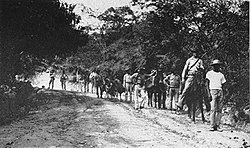
Despite the difficulties known by the Federalists, the Royalists were, too, immobilized by internal strife. The support of the Military Governors proved invaluable to the Huetlatoani and brought many early victories. But a successful push-back from Machimaleh’s elite troops immobilized the front and stopped the advance of the royalists. Furthermore, the loyalty of the Military Governors was not free and they demanded more guarantees, liberties, and privileges, and more importantly for it to be enshrined in a constitution. Conflicts between Absolutists and Constitutionalists proved to be as devastating for the Royalists as the war with the Federal Government, if not more so.
Rise of the Calpullists
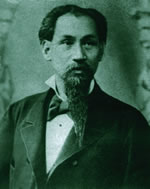
It was in this context of anarchy that Maxtatlon became recognizable public figures. Maxtatlon was the theoretician of a form of Socialism known as “Nocalli tlahtōlli”, or “Calpullism”. A long time political activist, classified as either socialist or anarchist, forced into illegality by both the Monarchists and the Reformists. After the Revolution, he found refuge in the province of Yepeacac, and promoted among the population his system of a “federation of independent communes, where lands and tools are collectivized, and where private property is abolished in favour of the right given by the labour of the workers”. It quickly proved to be extremely popular in agricultural settlements, where the new “Calpulli” organized following Maxtatlon’s instructions, started to set up credit unions and Mutual Insurances. The farmer-bandits of the regions were reorganized into fully fledged militias called the “Red Jackets” and the “Black Vests”, led by some of Maxtatlon’s closest associates, such as Coatzontli, Cuexatlan and Quixhetlin.
The Calpullist became the dominant faction of Yepeacac Altepetl’s countryside, remaining a rural movement still considered to be a “bandit uprising”.by other factions. Coatzontli, Cuexatlan, and Quixhetlin, the Three Generals of the Calpullists, victories over the Federalists and then their conquests of the Province’s urban centers, changed the population’s opinion on them, and confirmed their group's position as one of the “noteworthy” factions by stopping a Royalist incursion in their territories.
All over the country, territories on the border between the Federalists and the Royalists knew spontaneous revolts claiming to be “Calpullists” in nature. Cuexatlan and Quixhetlin were notably sent to instruct and educate these new “Free Calpotlin”, and to organize their military resistance against other factions. Not all of these revolts, nor all of the generals’ operations, were successful, but the infamy and the size of the Calpullist faction quickly grew nonetheless.
Meanwhile, Coalzontli took the lead of the military operations against the Royalists. Helped by grassroots uprisings started spontaneously or favored by his agents in the Royalists-held territories, and following a no-direct-fighting policy against his better equipped opponents, Coalzontli managed to gain a series of strategic victories against them, and even obtained the surrender of important royalists cities which had lost all of their countryside and had their supply lines cut by the Calpullist General.
A second campaign, led by Cuexatlan, began after Coalzontli early successes. Cuexatlan managed to cut the grass under the feet of his Federalist rival, the Warlord Teccizmitl, by invading and defeating the Secessionists states of Yucu Dzaa and Guie Ngola and then crushing Teccizmitl, who had been forced to rush his own planned invasion of the Secessionists, at the Battle of Singers Road. This quick rise of the Calpullists mark the end of the first part of the Thousand Colors War.
End of the War
After the suppression of the monarchists as a credible threat and the crushing defeat of the Teccimitzl at the battle of Singers Road, the uneasy truce between the Federalists and the Calpullists was no longer beneficial to either side. Mextatlon published his “Denunciation of the Federalists”, a text presented as an “aggressive demand for reforms and for the liberation of all the workers”. It would serve as a de-facto declaration of war.
The armies led by the Three Generals proved to be more experimented, better equipped, and to have a better morale than most of the Federalists troops, still divided among their allegiances to competing Warlords and limited by their lack of real funds. At the battle of Pachyohcan, the last elite army of the FRUA was annihilated by Coalzontli”s columns. After the Second Battle of Azcapotzalco, the last remaining Federalists leaders fled to other cities to find refuges, but ended up caught and imprisoned by the Calpullists through various events.
To symbolically end the conflict, even if it would take many more months to crush the last pockets of Federalist resistances, Maxtatlon organized the first “Cepan Mochicalpulleh”, the “Assembly of the All the Calpotlin”, in Hueynochtlan, a city near the devastated Azcapotzalco. It’s this Assembly that officially proclaimed the liberation of “All the Children of the Lands, the destitution of all “reactionary institutions”, and the creation of the “Coalition of the Coconeh Calpotlin”.
Maxtatlon Regime
Major combats of the War of Thousand Colors ended in 1924. The regime consolidated its popularity among the peasants through a program of Collectivisation, Land Reforms, installation of Workplace Democracy and shared-ownership of the enterprises, extension of the network of Mutualists banks and insurances, and so on. Under Maxtatlon, the decentralization process was pushed to its maximum, with the disbanding of all units that had served under the Calpullists and the creation of “Calpulli Autonomous Divisions” in charge of protecting and securing their respective Districts. It’s only pushed by his remaining two generals, Cuecuex and Quixhetlin, that Maxtatlon approved and allowed the Cepan Mochicalpulleh to vote the creation of the “Supra-Calpotlin Fighting Force”, a Federal Military of a sort that was put under Quichetlin’s direction.
Maxtatlon’s time as the Head of State of the recently created Coalition is remembered for its idealism and pursue of a perfect form of Calpullism bordering on Anarchism. Between 150,000 and 200,000 “Calpulli Wards” and other landowners, or simply peasants supposed to be wealthy, died during the Collectivisation, and another 100,000 political opponents may have been purged by the Calpullists, even if concrete evidences are lacking.
Cuecuex Regime
Cuecuex had been nominated by Maxtatlon and elected by the Cepan Mochicalpulleh as head of the "Workers and Farmers Inspectorate", one of the few “Federal” institutions that Maxtatlon agreed to create. Cuecuex used his position and network of allies and partisans to consolidate his powers. When Maxtatlon died in 1928, Cuecuex was ready to take over. The same year, Quixhetlin whom had become his rival, and his partisans were either arrested or exiled. Through political manoeuvering, Cuecuex partisans had taken over most of the police forces and Calpullec positions which, when added to Cuecuex's own control of the Inspectorate and friendly relations with the Intelligence Services, paralyzed Quixhetlin's "Supra-Calpotlin Fighting Force" and left him defenseless. His last rival gone, Cuecuex was confirmed "Leader" of the Coalition and successor to Maxtatlon.
Where Maxtatlon pursued an utopian program, trying to decentralize the country and to destroy all form of statehood in favor of free associations, Cuecuex instead re-inforced "Intercalpotlin" (or Federal) institutions. While he disbanded the Supra-Calpotlin Fighting Force", he merged together all "Calpulli Autonomous Military Divisions” into a single Coalition Armed Forces. He also created Coalition Law Enforcement Units to deal with cases concerning multiple Calpulleh. One of his most important decision was to merge all local mutual banks into a single supra-district credit union serving as a central bank. By 1932, Cuecuex had established a pseudo-executive government and was de-facto the sole authority of the Coalition, the Cepan Mochicalpulleh being too bloated to serve any actual political role and Cuecuex' partisans inside allowed him to bypass the Assembly entirely, even if he kept the appearance of a parliamentary regime.
However, Cuecuex did not ease off the “Anti-Drugs Campaign” the nickname given to the various policies put into place by the Coalition against religious groups and other activities considered to be threats to the Workers' consciousness and freedom. Thousands of Temples, Pyramids, and other holy grounds, were destroyed by the Calpullists, and ten of thousands of priests and religious, called “Mystics” by the Regime, were imprisoned or killed. was accompanied with book-burnings, destruction of art pieces considered to be “the products of mystical, reactionary, thinkings” and public disowning of faith obtained by force from old believers.
Industrialization
Now in control of virtually all institutions of the Coalition, Cuecuex began his project to reform and strengthen the economy. In 1932 the Cepan Mochicalpulleh approved the Inter-districts Cooperation Initiative, a project aiming to specialize all Calpulleh into three broad economic categories : agricultural, industrial, and Commerce. The 1933 census revealed that more than 75% of all Calpullis were Agricultural. Using propaganda, Cuecuex mobilized the population in support of industrialization. Cuecuex encouraged to make full use of the "unused workforce" of the countryside, and expanded the Mutual credit system as a way to pay the workers building the power stations, Rail transport, and factories required to meet Cuecuex' vision of an entirely economic independent Coalition.
New Calpulleh were created around these new factories, such as Calpulli Caxtōlli-Omōme which was used by the Coalition's propaganda as the finest example of the success of the ongoing industrialization.
To keep the appearance of the Coalition being a Stateless society, Cuecuex and his closest partisans, with the help of pannels of invited experts, engineers, and other specialists, were the ones drafting the industrial projects, such as dams, railroads, and iron mills, before Cuecuex presented them to the Cepan Mochicalpulleh to be voted. Representatives were even allowed to present their own projects to the Assembly, even if they had to be approved by Cuecuex and his teams of experts first. Once projects were approved, the Assembly emitted a contract-offer open to all Construction Companies with an account in the Inter-districts Mutual Bank. In truth, it was Cuecuex again who planned which Company would get which contract, to accelerate the process. Thus despite the apparent economic freedom left to all actors, the Inter-Districts Cooperation Initiative was really piloted by Yancuicopan, at every level.
Geography
Biodiversity
Climate
Politics
Government

The government is led by a Calpuleque or "Leader". The Calpulequeis elected by the Copan Mochicalpulleh, the Assembly of All Representatives. The Calpuleque is in charge of supervising and coordinating the various "National" or "Federal"-level institutions of the Coalition, such as the Military, the Inter-Districts Law Enforcement, the Inspectorate, Intelligence Services, the central bank, or the National Insurance Agency. The Directors of these institutions are elected, recalled, and/or replaced by the Copan Mochicalpulleh, and they form with the Calpuleque at their head the de-facto Executive of the Coalition. At the end of each years, the Calpuleque and the Directors have to present a "bilan" of their agencies' activities during the year and answer the questions of the Representatives, who will then decide to keep the Calpuleque or Director, replace him, or even call-in the judiciary if they consider that he has committed grave crimes against the Coalition and its citizens.
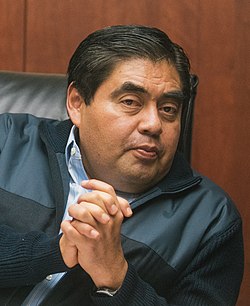
Thus at the heart of political activities in the Coalition is the Copan Mochicalpulleh (Assembly of all the Representatives), the legislative branch of the Coalized State, with a seat for the representatives of each Calpullis originally, and now for the Representatives of each Districts Associations. The Assembly fix the budget allowed to each Agency, to the military, has the power to declare wars, change laws, create "Economic plans", among various other powers bestowed to it by the 18 Atemoztli Constitution. However each years, a quarter of the Representatives have to return to their Districts to present the bilan of their activities to their People's Council, made of anywhere between 29-to-689 randomly selected District-citizens. The People's Council then decide whether or not confirm the Representative for another year, start an election process (involving the entirety of the Calpulli's citizens) to replace him, and maybe even to call-in the local prosecutor to start an in-depth investigation on the ex-Representative. It's the newly constituted Assembly who then, once back to Hueynochtlan who will then judge the members of the Executive in a similar fashion.
The President of the Assembly, the Tlacaquini is elected for one mandate of one year during which he preside the debates, the discussions, fix the agenda of the Assembly, supervise the various Committees, and rule over the maintenance of the buildings belonging to the Copan Mochicalpulleh.
Judiciary
Despite its ideological disdain for "Old Things", the Coalition's judicial system remain very similar to that of the Tlatholoyan that preceded it. It is made up of multiple courts with differing levels of jurisdiction. These include the trial courts, appellate courts, and the Supreme Court.
At the bottom of the judicial hierarchy is the District Judge, equivalent of a Small claims court, elected by his Calpulli to hear minor criminal and civil cases and issue mandates. Originally thought as fully autonomous court during the Maxtatlon Era, District Judge have lost most of their powers, recovered by the Teccalli courts. Civil judgments by this court are considered final, but criminal sentences can be appealed and are then sent to the Tlacxitlán. The Tlacxitlán also serves as trial courts in case involving politicians or relatively high-ranking public agents. The Supreme Court then review the decisions made by the Tlacxitlán and is itself is in charge of cases involving government officials such as the Achcautli. The Supreme Court is led by the Cihuacoatl, nominated by the Achcautli and elected by the Representatives.
Various special jurisdiction courts exist, such as family courts, fiscal affairs courts, and a military court. Major breaches of professional ethics, including bribery, accepting gifts, and colluding with a party to a case, is punishable by death.
Individuals accused of crimes or involved in civil disputes are summoned to court and have the opportunity to defend themselves with the help of a lawyer, under the supervision of an attorney, in a public trial.
Administrative Divisions
The Coalition is made of the free association of 25,359 Calpulli. Each Calpulli is determined following a various criteria of size, economic activity, cultural makeup, and infrastructures requirements such as all Calpulli being capable of maintaining at least one school. During the first years of the COalition, all these Calpulli were considered to be entirely autonomous and independents from one another, with the "central state" offering only the bare minimum of national services. With time, power went away from the Calpulli and to the various "Free Associations of Calpullis", numbering around 2500. It's these Free Associations that now send Representatives to the Assembly, and have taken over many prerogative previously reserved to Calpullis, such as guaranteeing the access to fresh water and electricity.
Military
Economy
The Coalition describe itself as a Mutual economy or an "anti-capitalist free market" where there's is no money but a money system accounting for exchange or credit clearing. Mutual credit accounting emphasises the importance of balanced exchange, where every credit is matched by an equal and opposite debt. All citizens of the Coalition are thus required to posess an account at the Intercalpotlin Mutual Bank, which keeps track of the evolution of credits and debts as emmited by every citizens. "Hoarding" and "Over-consumption" are both penalized and can result in either "forced donations" or "civic work" to repay one's debt to society. The director of the Intercalpotlin Mutual Bank, since it is technically a Credit union, is elected by every account holder on the principle of "one person, one vote".
the Calpotlin Coalition officialy does not recognize capitalist private property but officialy enshrined the idea of personal property, a type of private property with strong abandonment criteria.
Agriculture
All lands in the Coalition are communal, belonging to the Calpulli. Community members individually farm designated parcels and collectively maintain communal holdings. They can use their allotted parcels indefinitely as long as they do not fail to use the land for more than two years and they can pass their rights on to their children.
The main cereals cultivated in agricultural Calpulli are maize, rice, Amaranth, and chia. They are generally cultivated alongside beans, chilies, and squashes. Cotton and Hemp are grown for the needs of the textile industry, and chocolate can be found in the south-eastern regions.
Industry
Nominally, the Coalition is a Free Market and while enterprises are collectively owned, the public sector remain relatively small. Calpulli are thus free to choose in which industry they wish to compete. In practice, the State's possess many ways to incentivise collective actors to go one way or another. Food industry and textile, alongside other light industries remain vital to the Coalition's economy, who has been a major producers of many households appliances both for its internal market and for the international. Heavy industries, such as the automotive and aircraft industries, started out of the Central Authorities' concern over the CCC's army perceived backward situation compared to the rest of the Eastern Continents and the following subsidies and privileges they gave to Calpulli who decided to specialize in these industries. These enterprises were then allowed to turn back to the private sectors once the industrial gap had been considered "filled".
However, the main sector in the Coalition in term of production remain the Chemical industry, with Calpulli specialized in the production of plastic, animal health products, crop protection chemicals, and other consumer products like soap or detergents. The Chemical industry represent 10% of the Coalition's GDP.
Financial and banking system

The chief instrument of financial and fiscal control is the Intercalpotlin Mutual Bank. It fulfills many of the functions of other central and commercial banks. While it doesn't issue the Mutual credits, which are created and destroyed with each financial transaction, it does control its circulation and plays an important role in disbursing budgetary expenditures. While citizens aren't required to own an account in the Bank, they would be unable to pay or receive payments in Mutual Credits without it and thus unable to make any kind of transaction in the Coalition. This include government organizations and other bodies, which enables it to exert thorough supervision over their financial and general performances.
International trades, Remittances, and currency exchanges are handled by Pochteca Unions. These Unions are chartered by the Coalition and are typically owned by the members of a single Calpulli, who are also its employees and main users, called the Pochteca. Pochteca play a vital role in the Coalition's economy, as they're the main handlers of foreign currencies and are allowed to operate in foreign markets.





